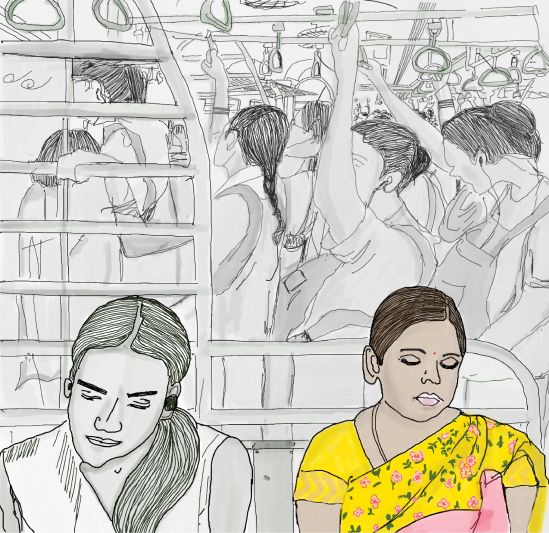Quantify or Qualify?

Quantify or Qualify?
This research is being conducted under the women4climate mentorship program by C40 cities in collaboration with the Ministry of Environment and Climate, Maharashtra. The Mentee, Vidisha Dhar, is supported by her mentor Lubaina Rangwala from WRI, urbz collective and Anamika Sarker, a student of the built environment at the Jindal School of Art and Architecture. Vidisha is an urban designer trained in participatory planning, mobility and urban data. She is adding climate as a new component to her particular focus in mobility and participatory planning, following the requirements of this fellowship.
The first phase of this research, which is at the conjunction of mobility and climate, tests the validity of a hypothesis made earlier- that men from a higher economic group release more carbon emissions than their female counterparts or their contemporaries from poorer economic backgrounds in their travel choices. While previous formulations of this phase had framed the approach as wanting to “prove” the truthfulness of this claim, the methodology has been re-evaluated to allow the research to test rather than prove. Since the subject of study in this first phase is very precise- to document the carbon emissions from personal travel choices- the data collection method for this phase should also emulate this precision. For this reason, it will be helpful to use quantitative data directly wherever possible or collect data which numbers could just as easily represent. The other reasons for choosing a quantitative methodology of research in this phase are:
Diverse participation and reduced respondent fatigue enable many participants to participate in the study. Given that the research examines a claim that identifies the travel behaviour of the entire city of Mumbai, it is critical to address respondents' diversity to document the travel patterns of a variety of people across gender, age, income level, and geography. The brief questionnaire asks about the kind of transportation used, travel duration, and the distance travelled. With the support of the existing emission standards for vehicles, the answers to these specific questions would enable us to calculate the CO2 emissions of every journey. This research will only consider vehicle typology, not vehicle size. Thus, a questionnaire would allow us to engage with extensive and diverse individuals in a short time.
Randomising samples- In Mumbai, every commuter has a unique travel journal. Their choices are affected by their location, socio-economic strata, gender, age, comfort and several other factors. Earlier, the research recorded such travel patterns by collecting data from various households in two distinct neighbourhoods. However, the organisation of our sample size has now been amended. It is realised that limiting the sample size to a neighbourhood or a household will only record data representing similar kinds of people and their travel behaviour since it will be collected from the exact geographic location, income group etc. Hence, instead of using the previously thought neighbourhood and household selection route, the data will be collected by randomly distributing a short questionnaire and then classifying the collected data roughly based on previously discussed categories. Randomising the sample size will prevent data collection from a specific group of people and allow more respondents across the city with their unique commuting patterns to contribute to the research.
Logistical simplicity- Notwithstanding the positive effects of precise data collection, data randomisation and larger sample sets on our hypothesis testing, there are also practical reasons for choosing to employ a quantitative research method for the first phase. Given that the team of researchers presently comprises two people, of which only one is based out of Mumbai, the data collection process needs to be as streamlined and logistically manageable as possible.
However, the researchers undertaking this research also recognise quantitative research's limitations, especially regarding matters of the social sciences. All ways of conducting quantitative research also operate within the domain of ethics[1]. While the first phase tests the CO2 emitted by commuters in Mumbai, the researchers recognise that there are a host of reasons that compels people to make the choices for everyday travel, and not all experiences are pleasant or comfortable. For instance- A woman who first takes a 15 min walk to the neighbouring local train station, then travels 26km (1 hr 45 min) on the local train, then takes a crowded bus 10 min and finally walks for another 5 min and resumes house chores after completing her journey has minimal contribution to the carbon emissions but is undergoing a strenuous although pocket-friendly commute in each direction every day. Such experiences highlight the challenges an individual faces in taking public transport for their daily commute. Secondly, the authors undertaking this research do not treat people undergoing these experiences as a subject of study. Quantitative and computational data collection methods universalise the subject “population” or “sample size.”For our study, which seeks to understand both the effects of travel behaviour on carbon emissions and to grasp the experience of these trips in the second phase, the study employs qualitative data collection methods for the latter half.
As daily public transport users, the authors see themselves as part of the context, not outsiders. Through this lens, the research attempts to unravel the tale of the daily commute beyond the consequence of low carbon emission and shed light on experiences behind the recorded travel patterns. While the circumstances that people are subjected to while commuting may or may not be the same, their effects on their daily lives and routines can be very different. This second part of the research aims to record the daily commuters' real-life stories to underscore the differences between the two gender groups and across income groups. The qualitative data collection in this phase will be collected through semi-structured interviews to discuss the everyday experiences of commuters before and after commuting. The interviews will be recorded unless the point of diminishing interviews is reached. In addition, focused group discussions will be conducted amongst the two groups- homogeneous and heterogeneous. The expressions from the commuters will then be bifurcated into knowledge, ideas and subjectivity[2]. In the end, this research highlights the infrastructural shortcomings that prevent citizens from using public transport and suggests recommendations to make public transport comfortable for commuters.
Refrences-
[1] https://link.springer.com/article/10.1007/s10551-017-3549-8
[2] https://urbz.net/articles/kind-data-we-mine-will-determine-kind-city-we-live


